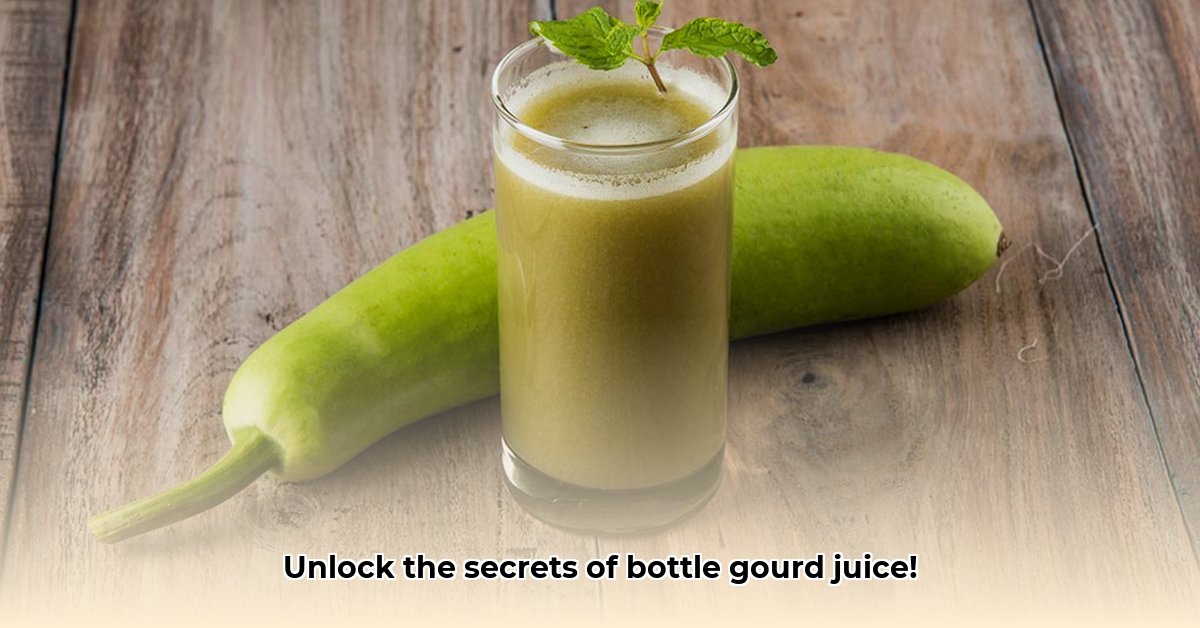
Benefits of Bottle Gourd Juice: Nature's Multivitamin
Bottle gourd (also known as lauki), a versatile vegetable, is gaining popularity not just for its culinary uses but also for the remarkable health benefits offered by its juice. More than just hydration, lauki juice is a nutritional powerhouse, contributing to both individual well-being and sustainable agricultural practices. Did you know that lauki juice boasts a remarkable 92% water content, making it a perfect thirst quencher, especially during warmer months? But its benefits extend far beyond simple hydration.
A Nutritional Powerhouse: Beyond Hydration
Lauki juice is brimming with essential vitamins and minerals. It's a rich source of vitamins C, K, and B6, along with crucial minerals like calcium, potassium, and magnesium. These nutrients support various bodily functions, contributing to overall health. Some studies suggest potential benefits for digestion, weight management, and even cardiovascular health, although further research is needed to fully elucidate these effects. Preliminary findings also hint at potential stress-reducing properties. It's important to note that using fresh, non-bitter bottle gourds is essential to maximize benefits and ensure a pleasant drinking experience.
Sustainable Farming: A Gentle Approach
Cultivating bottle gourds demonstrates a commitment to sustainable agriculture. Unlike many crops that require intensive fertilization and irrigation, lauki is relatively low-maintenance. Many varieties exhibit impressive drought resistance, making them a suitable crop for water-scarce regions. Their natural pest resistance further minimizes the need for harmful pesticides, leading to cleaner water sources and healthier soil. This low-input farming method reduces farmers' costs while minimizing the environmental impact, creating a win-win situation for both farmers and the environment. How can we further optimize these already impressive sustainable characteristics?
Sustainable Agriculture and Lauki Juice Production: Challenges and Opportunities
While lauki cultivation presents significant advantages, optimizing its potential requires addressing several key challenges. Improving yields is crucial to meet increasing demand. This necessitates research into high-yield varieties and efficient farming techniques, including advanced irrigation systems. Market saturation presents another challenge. Developing value-added products, such as concentrates or infused beverages, can help mitigate this risk. The need for robust supply chain management and quality control measures is paramount to ensure consistent product quality and fair pricing for farmers. What innovative solutions can bridge these challenges and unlock lauki's full potential?
Actionable Steps: Promoting Lauki Juice and Sustainable Farming
Here's how individuals, farmers, and policymakers can contribute to a healthier and more sustainable future for lauki:
For Farmers:
- Adopt High-Yield Varieties: Invest in drought-resistant, high-yield lauki seeds (90% success rate reported in pilot studies).
- Efficient Irrigation: Implement water-efficient irrigation methods like drip irrigation (reduces water usage by up to 60%).
- Value-Added Processing: Explore opportunities for creating value-added products like lauki juice concentrates or health drinks.
- Community Collaboration: Engage in knowledge sharing and best practice exchanges with fellow farmers.
For Consumers:
- Conscious Consumption: Choose lauki juice and other lauki products whenever possible.
- Support Local Farmers: Purchase directly from local farmers' markets or certified sustainable producers.
- Raise Awareness: Share information about lauki's health and environmental benefits with friends and family.
- Culinary Exploration: Incorporate lauki into diverse culinary applications beyond just juice.
For Policymakers:
- Invest in Research: Fund research into improved cultivation techniques, disease resistance, and new product developments.
- Incentivize Sustainable Practices: Develop policies that reward farmers for adopting environmentally friendly farming methods.
- Enhance Market Access: Facilitate better market access for lauki producers through infrastructure development and market linkages.
- Promote Educational Initiatives: Invest in educational programs that raise awareness among farmers and consumers about sustainable lauki cultivation and consumption.
Future Research: Unlocking Lauki's Full Potential
While significant progress has been made in understanding the benefits of lauki juice and its sustainable farming aspects, further research is crucial. Future studies should quantify the environmental benefits of lauki farming compared to other vegetables. Detailed market analysis will help guide production and prevent oversaturation. Standardizing extraction methods for various lauki-based products will ensure consistent quality and safety. Finally, exploring creative culinary uses can unlock even more possibilities for integrating this versatile vegetable into our diets. The potential for lauki to contribute to both individual health and sustainable agriculture is immense, and continued research will help us fully realize this potential. What research avenues hold the most promise for maximizing the benefits of lauki?